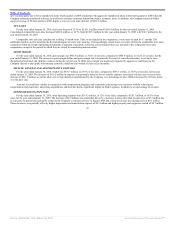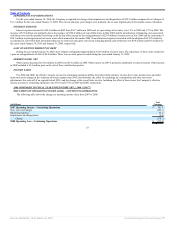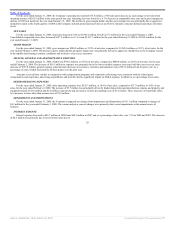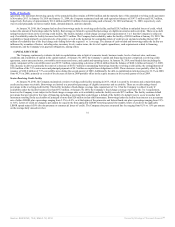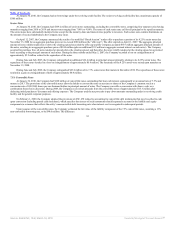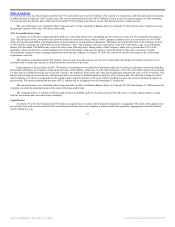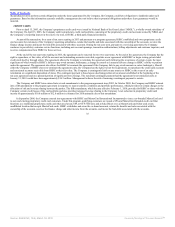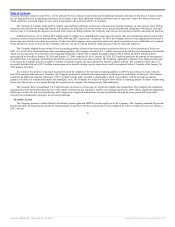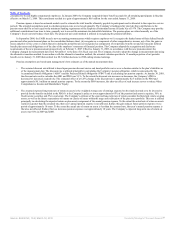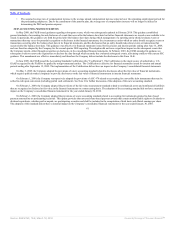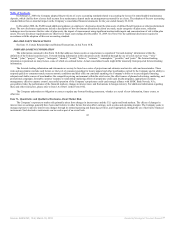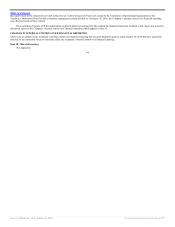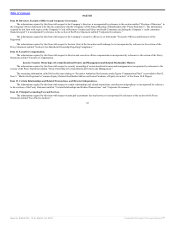Saks Fifth Avenue 2009 Annual Report Download - page 38
Download and view the complete annual report
Please find page 38 of the 2009 Saks Fifth Avenue annual report below. You can navigate through the pages in the report by either clicking on the pages listed below, or by using the keyword search tool below to find specific information within the annual report.
Table of Contents
CAPITAL NEEDS
The Company estimates capital expenditures for 2010 will be approximately $55 million, net of any proceeds including tenant allowances, primarily for
store renovations, enhancements to management information systems, maintenance capital and replacement capital expenditures.
The Company anticipates that working capital requirements related to existing stores, store renovations and capital expenditures will be funded through
cash on hand, cash provided by operations and the revolving credit facility. Maximum availability under the revolving credit facility is $500 million, and there is
no debt rating trigger. During periods in which availability under the facility exceeds $87.5 million, the Company is not subject to financial covenants. If
availability under the facility were to decrease to less than $87.5 million, the Company would be subject to a minimum fixed charge coverage ratio of 1 to 1.
During 2009, weighted average letters of credit issued under this credit facility were $25.7 million and letters of credit reduce the amount available to borrow.
The Company expects that its cash flows from operating activities combined with borrowings under its revolving credit facility will be sufficient to sustain its
current level of operations.
CRITICAL ACCOUNTING POLICIES AND ESTIMATES
The Company’s critical accounting policies and estimates are discussed in the notes to the consolidated financial statements. Certain judgments and
estimates utilized in implementing these accounting policies are likewise discussed in each of the notes to the consolidated financial statements. The following
discussion sets forth the judgments and uncertainties affecting the application of these policies and estimates and the likelihood that materially different amounts
would be reported under varying conditions and assumptions.
REVENUE RECOGNITION
Sales and the related gross margin are recorded at the time customers provide a satisfactory form of payment and take ownership of the merchandise.
Revenue associated with gift cards is recognized upon redemption of the card. There are minimal accounting judgments and uncertainties affecting the
application of this policy. The Company estimates the amount of goods that will be returned for a refund based on historical trends and reduces sales and gross
margin by that amount. However, given that approximately 23% of merchandise sold is later returned and that the vast majority of merchandise returns occur
within a short time after the selling transaction, the risk of the Company realizing a materially different amount for sales and gross margin than reported in the
consolidated financial statements is minimal.
COST OF SALES AND INVENTORY VALUATION
Merchandise inventories are stated at the lower of cost or market using the retail method. On February 3, 2008, the Company elected to change its method
of costing its inventories to the retail “first-in, first-out” (FIFO) method, whereas in all prior periods inventory was costed using the retail “last-in, first-out”
(LIFO) method. The new method of accounting had no impact on the fiscal years ending January 30, 2010, January 31, 2009, and February 2, 2008 as the LIFO
value exceeded the FIFO market value and inventory had been adjusted to reflect FIFO market value in all periods. Under the retail method, the valuation of
inventories at cost and the resulting gross margins are determined by applying a calculated cost-to-retail ratio to the retail value of inventories. The cost of the
inventory reflected on the consolidated balance sheet is decreased with a charge to cost of sales contemporaneous with the lowering of the retail value of the
inventory on the sales floor through the use of markdowns. Hence, earnings are negatively impacted as the merchandise is being devalued with markdowns prior
to the sale of the merchandise. The areas requiring significant management judgment include (1) setting the original retail value for the merchandise held for sale,
(2) recognizing merchandise for which the customer’s perception of value has declined and appropriately marking the retail value of the merchandise down to the
36
Source: SAKS INC, 10-K, March 18, 2010 Powered by Morningstar® Document Research℠


